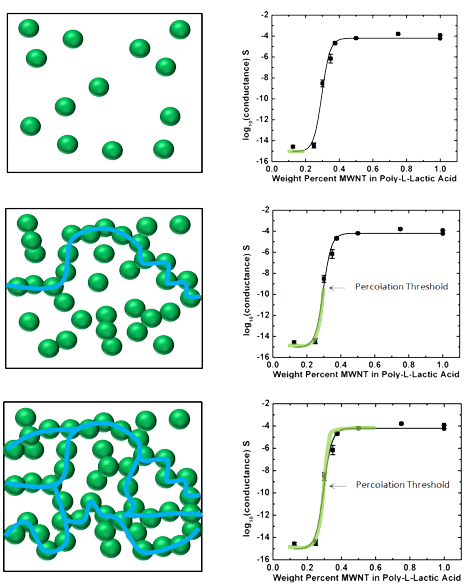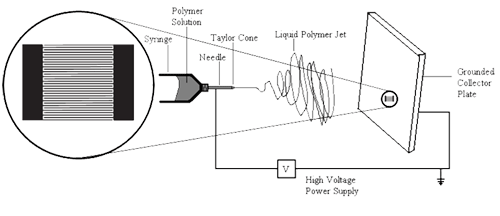Percolation in Confined Geometries
- The study of electrical percolation within carbon-nanotube polymer composites in complex geometries such as fibrous mats, is undertaken from both computational and experimental perspectives. We have identified interesting finite-size effects that are experimentally accessible for carbon-nanotube composites in thin film or fibrous geometries.
- Percolation is a process by which paths are formed that pass through random media. Water, electrical current, or fire can all travel via percolative paths (i.e., water within rocky soil, current within a composite materials, or fire jumping from tree top to tree top). For a composite material, conducting paths which span the sample can be formed within a non-conducting matrix with the addition of a conducting dopant, enabling an insulating polymer matrix to conduct current. This process occurs in three stages (as illustrated below). At low loading levels, the dopant is isolated and thus, no paths are formed. As the dopant level is increased a single path forms, which is associated with a dramatic increase in conductivity. The conductance of the composite will increase as more paths are formed until the network has become saturated. This "cartoon" depicts percolation in a homogeneous medium; however the data is from an electrospun sample with 70% porosity. We are interested in how volume confinement and changes in dimensionality affect the percolation process for such complex samples.

- As one experimental example of percolation within confined geometries, in order to study fundamental mechanisms of electrical percolation, due to the high porosity (~70% void space) and thin-ness (typically ~few microns thick) of the nanofibrous samples, we electrospin directly onto interdigitated electrodes (IDEs) in order to perform sensitive conductance measurements. Prepared samples are placed in a vacuum system and I-V curves are measured with a subfemto-ammeter to determine electrical conductivity levels as low as 10-13 S/cm.

- D. R. Stevens, E. W. Skau, L. N. Downen, M. P. Roman, and L. I. Clarke, "Finite-size effects in nanocomposite thin films and fibers," Phys. Rev. E 84, 021126 (2011). (journal) [paper]
- D. R. Stevens, L. N. Downen, and L. I. Clarke, "Percolation in nanocomposites with complex geometries: Experimental and Monte Carlo simulation studies," Phys. Rev. B 78, 235425 (2008). (journal) [paper]
- S. S. Ojha, D. R. Stevens, K. Stano, T. Hoffman, L. I. Clarke, and R. E. Gorga, "Characterization of electrical and mechanical properties for coaxial nanofibers with poly(ethylene oxide) (PEO) core and multiwalled carbon nanotube/PEO sheath," Macromolecules 41, 2509 (2008). (journal) [paper]
- S. D. McCullen, K. L. Stano, D. R. Stevens, W. A. Roberts, N. A. Monteiro-Riviere, L. I. Clarke, and R. E. Gorga, "Development, optimization, and characterization of electrospun poly(lactic acid) nanofibers containing multi-walled carbon nanotubes," J. Appl. Polym. Sci. 105, 1668 (2007). (journal) [paper]
- S. D. McCullen, D. R. Stevens, W. A. Roberts, S. S. Ojha, L. I. Clarke, and R. E. Gorga, "Morphological, electrical, and mechanical characterization of electrospun nanofiber mats containing multiwalled carbon nanotubes," Macromolecules 40, 997 (2007). (journal) [paper]
Atmospheric Surface Science
Experimental Molecular Dynamics
Polymer Nanocomposites
Research Groups
NCSU User Facilities

